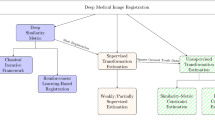Zusammenfassung
Deep learning based methods have not reached clinically acceptable results for common medical registration tasks that could be adequately solved using conventional methods. The slower progress compared to image segmentation is due to the lower availability of expert correspondences and the very large learnable parameter space for naive deep learning solutions. We strongly believe that it is necessary and beneficial to integrate conventional optimisation strategies as differentiable modules into deep learning based registration.
Chapter PDF
Similar content being viewed by others
Literatur
Blendowski M, Heinrich MP. Learning interpretable multi-modal features for alignment with supervised iterative descent. In: MIDL; 2019. p. 73–83.
Hansen L, Dittmer D, Heinrich MP. Learning deformable point set registration with regularized dynamic graph CNNs for large lung motion in COPD patients. arXiv preprint arXiv:190907818. 2019;.
Heinrich MP. Closing the gap between deep and conventional image registration using probabilistic dense displacement networks. In: MICCAI; 2019. p. 50–58.
Author information
Authors and Affiliations
Corresponding author
Editor information
Editors and Affiliations
Rights and permissions
Copyright information
© 2020 Springer Fachmedien Wiesbaden GmbH, ein Teil von Springer Nature
About this paper
Cite this paper
Hansen, L., Blendowski, M., Heinrich, M.P. (2020). Abstract: Defence of Mathematical Models for Deep Learning based Registration. In: Tolxdorff, T., Deserno, T., Handels, H., Maier, A., Maier-Hein, K., Palm, C. (eds) Bildverarbeitung für die Medizin 2020. Informatik aktuell. Springer Vieweg, Wiesbaden. https://doi.org/10.1007/978-3-658-29267-6_6
Download citation
DOI: https://doi.org/10.1007/978-3-658-29267-6_6
Published:
Publisher Name: Springer Vieweg, Wiesbaden
Print ISBN: 978-3-658-29266-9
Online ISBN: 978-3-658-29267-6
eBook Packages: Computer Science and Engineering (German Language)




